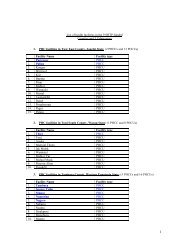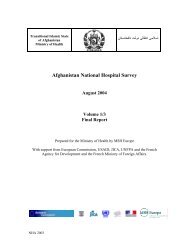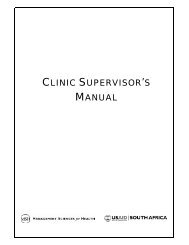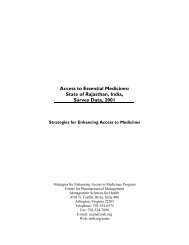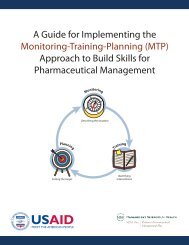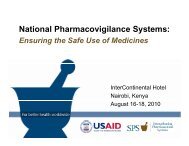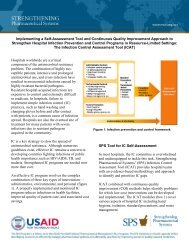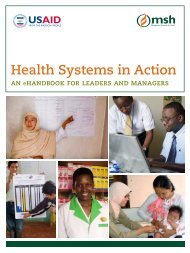Evaluation of Malawi's Emergency Human Resources Programme
Evaluation of Malawi's Emergency Human Resources Programme
Evaluation of Malawi's Emergency Human Resources Programme
You also want an ePaper? Increase the reach of your titles
YUMPU automatically turns print PDFs into web optimized ePapers that Google loves.
Management Sciences for Health<br />
<strong>of</strong> the equation is equally important. Without the capacity to deliver services—including<br />
adequate staff—facilities will be unable to meet the rising demand.<br />
Impact on Health Outcomes<br />
The ultimate goal <strong>of</strong> increasing the health workforce is to improve a country’s health<br />
status. Several studies have been undertaken in other countries linking health worker<br />
density to health outcomes. For example, there is a strong association between health<br />
worker density and maternal mortality 97 as well as increased levels <strong>of</strong> vaccination<br />
coverage. 98 In another study, a dynamic regression model was developed to evaluate the<br />
short and long term impact <strong>of</strong> changes in number <strong>of</strong> physicians per capita. 99 Using a data<br />
set <strong>of</strong> 99 countries, the regression model showed that increasing the number <strong>of</strong> physicians<br />
by one per 1,000 population resulted in a decrease in infant mortality <strong>of</strong> 15% within five<br />
years, and by 45% in the long run (half <strong>of</strong> which would be achieved in fifteen years).<br />
Impact on health outcomes is analysed in this evaluation by assessing the changes in<br />
service delivery, and thereby health outcomes, from the baseline year <strong>of</strong> the EHRP to 2009,<br />
with the assumption that the increased staff played a significant role in these health<br />
outcomes.<br />
The impact on health outcomes is measured by approximating the number <strong>of</strong> lives saved<br />
and morbidity averted as a result <strong>of</strong> the increased service utilisation described in the<br />
section above. At the completion <strong>of</strong> the upcoming DHS for Malawi in 2011, outcomes in<br />
terms <strong>of</strong> maternal, infant, neonatal, and child mortality rates can also be measured.<br />
The estimation <strong>of</strong> morbidity and mortality averted by increased service utilisation was<br />
made using the Lives Saved Tool (LiST) from the Spectrum suite <strong>of</strong> tools. 100 The<br />
changes in coverage for the HMIS indicators discussed in the previous section (antenatal<br />
care, trained deliveries, PMTCT, and immunisation) were input into the LiST tool for the<br />
span <strong>of</strong> the EHRP (2004 to 2009). Table 17 on the following page shows the<br />
interventions, percentage coverage in 2004 and 2009, and the resulting lives saved or<br />
infections averted based on the modeling (for complete results, see Annex S). 101 Note<br />
that OPD attendance is not included in this analysis because this is not a specific<br />
intervention and therefore cannot be used to calculate lives saved using LiST.<br />
97<br />
Lincoln Chen et al. <strong>Human</strong> <strong>Resources</strong> for Health: Overcoming the Crisis. The Lancet, Vol 364,<br />
November 27, 2004. pp. 1984 – 1990.<br />
98<br />
Sudhir Anand, Till Barnighausen; Health Workers and Vaccination Coverage in Developing Countries:<br />
AnEconometric Analysis. The Lancet. Vol 369, April 14, 2007. pp. 1277 – 1284.<br />
99<br />
Mansour Farahani et al. The Effect <strong>of</strong> Changes in Health Sector <strong>Resources</strong> on Infant Mortality in the<br />
Short-Run and Long Run; a longitudinal Econometric Analysis. Social Science and Medicine, No. 68,<br />
2009; pp 1918-1925.<br />
100<br />
The Spectrum suite <strong>of</strong> tools, developed by Futures Institute, is accessible online at<br />
http://www.futuresinstitute.org/Pages/Spectrum.aspx.<br />
101<br />
Note that impact presented in Table 17 represents an approximation based on pre-determined<br />
effectiveness coefficients for each intervention and using all default parameters for Malawi that are preloaded<br />
in the LiST tool and assuming 12% HIV prevalence for adults. An outcome assessment should be<br />
performed when information from upcoming DHS 2011 is made available.<br />
EHRP <strong>Evaluation</strong> Final Report Page 64



